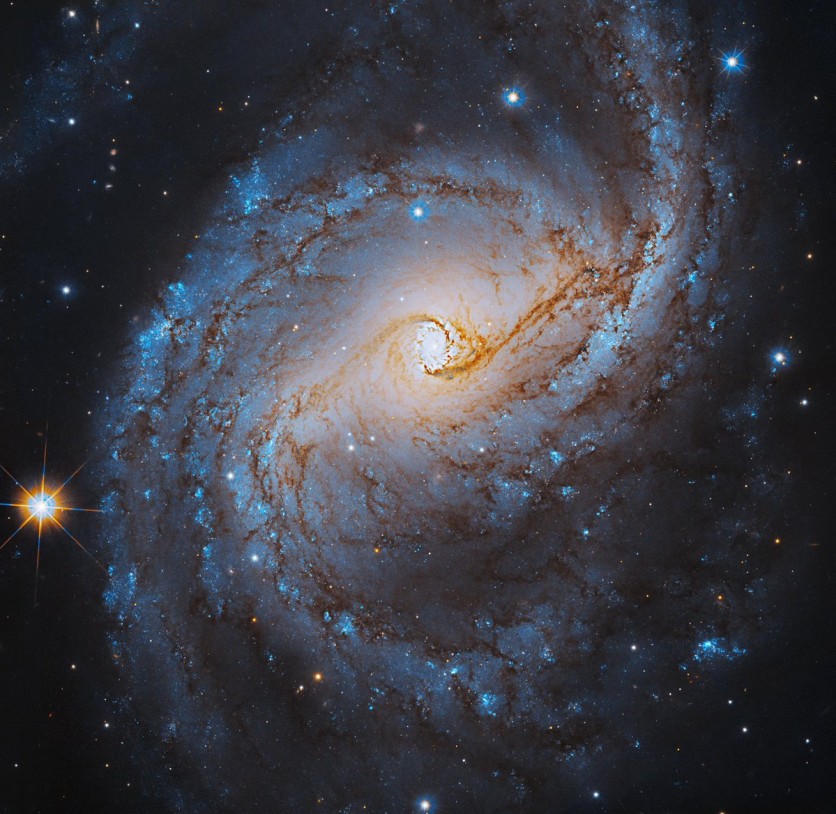NASA's Hubble Space Telescope has captured a striking image of NGC 6951, an intermediate spiral galaxy located 78 million light-years away in the Cepheus constellation.
This galaxy, discovered in the late 19th century by astronomers Jerome Coggia and Lewis Swift, has piqued scientific interest due to its intriguing stellar history.

Peak Period of Star Formation
NGC 6951 experienced its peak period of star formation approximately 800 million years ago, followed by a quiet phase lasting 300 million years before reinitiating the star-birthing process.
The star clusters within NGC 6951 boast an average age of 200 to 300 million years, although some date back as far as one billion years. Turbulent regions of gas, depicted in dark red, envelop the vibrant blue star clusters.
Astronomers commonly categorize NGC 6951 as a Type II Seyfert galaxy, a subtype of active galaxy characterized by substantial infrared radiation emissions and slow-moving gaseous matter near its core.
NGC 6951 experienced its peak period of star formation approximately 800 million years ago, followed by a quiet phase lasting 300 million years before reinitiating the star-birthing process.
The star clusters within NGC 6951 boast an average age of 200 to 300 million years, although some date back as far as one billion years. Turbulent regions of gas, depicted in dark red, envelop the vibrant blue star clusters.
Astronomers commonly categorize NGC 6951 as a Type II Seyfert galaxy, a subtype of active galaxy characterized by substantial infrared radiation emissions and slow-moving gaseous matter near its core.
'Circumnuclear Ring'
At the core of NGC 6951 rests a supermassive black hole enveloped by a ring of stars and a mix of gas and dust, approximately 3,700 light-years across.
This ring, referred to as the "circumnuclear ring," is believed to have formed between 1 and 1.5 billion years ago, sustaining ongoing star formation for much of its existence.
Scientists noted that interstellar gas traverses through the densely populated bar of the galaxy to reach the circumnuclear ring, providing the essential materials for sustained star creation.
A significant portion of the ring's mass, nearly 40 percent, consists of relatively youthful stars aged less than 100 million years. In addition, dark orange spiral dust lanes connect the galactic center to its outer regions, supplying extra material for potential star formation.
NASA noted that over the past 25 years, NGC 6951 has witnessed a series of remarkable celestial events known as supernovae, with researchers documenting as many as six of these occurrences.
Extensive studies of this galaxy are underway to garner a deeper understanding of the environments conducive to such supernova events. The analysis of emissions from supernovae plays a crucial role in comprehending the precursor star, encompassing details like its age, luminosity, and position.
The image presented here was crafted using data collected by Hubble's Wide Field Camera 3 and Advanced Camera for Surveys, capturing a spectrum of both visible and infrared light.
In related news, NASA's James Webb Space Telescope unveils a mesmerizing tapestry within the Orion Nebula, showcasing a stellar spectacle that defies the imagination.
These awe-inspiring images, now accessible through the European Space Agency's ESASky application, offer a portal into the heart of one of the night sky's most glorious wonders.
Learn more about this story by clicking here.
Related Article : NASA's Hubble Space Telescope Snaps Cigar Galaxy Billowing Red Smoke

ⓒ 2025 TECHTIMES.com All rights reserved. Do not reproduce without permission.




